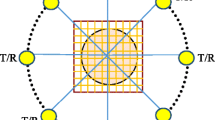Abstract
Purpose
The purpose of this paper is to propose a novel strategy to detect small calculi efficiently.
Methods
The proposed calculus detection strategy focuses on decorrelation of forward scattered waves caused by the failure of Born’s approximation. A calculus causes waveform changes of transmit pulses, resulting in a decrease in the cross-correlation coefficients calculated from IQ signals scattered near the calculus position. Therefore, we can detect calculi from the appearance of dips in correlation coefficients.
Results
When a calculus exists in a digital tissue map, sharp and deep dips in cross-correlation coefficients between acoustic IQ signals appear around the calculus. By contrast, no apparent dip exists when a tissue map contains no calculus. A scan line interval of 0.2 mm or less is appropriate for the conditions simulated in this paper, and the proper transmit focal range for the proposed method is at a calculus range.
Conclusion
These results imply that the proposed strategy can improve the efficiency of US devices for small calculus detection.









Similar content being viewed by others
References
Özdemir H, Demir MK, Temizöz O, et al. Phase inversion harmonic imaging improves assessment of renal calculi: a comparison with fundamental gray-scale sonography. J Clin Ultrasound. 2008;36:16–9.
Fowler KAB, Locken JA, Duchesne JH, et al. US for detecting renal calculi with nonenhanced CT as a reference standard. Radiology. 2002;222:109–13.
Lamb PM, Perry NM, Vinnicombe SJ, et al. Correlation between ultrasound characteristics, mammographic findings and histological grade in patients with invasive ductal carcinoma of the breast. Clin Radiol. 2000;55:40–4.
Jacob D, Brombart JC, Muller C, et al. Analysis of the results of 137 subclinical breast lesions excisions. Value of ultrasonography in the early diagnosis of breast cancer. J Gynecol Obstet Biol Reprod (Paris). 1997;26:27–31.
Mahnken AH, Mühlenbruch G, Das M, et al. MDCT detection of mitral valve calcification: prevalence and clinical relevance compared with echocardiography. Am J Roentgenol. 2007;188:1264–9.
Liu F, Coursey CA, Grahame-Clarke C, et al. Aortic valve calcification as an incidental finding at CT of the elderly: severity and location as predictors of aortic stenosis. Am J Roentgenol. 2006;186:342–9.
Janetschek G, Putz A, Feichtinger H. Renal transitional cell carcinoma mimicking stone echoes. J Ultrasound Med. 1988;7:83–6.
Roesel GC, Toepfer NJ, Battino BS, et al. A calcified papillary renal cell carcinoma masquerading as a renal pelvic calculus. Curr Urol. 2007;1:217–8.
Finn HM, Johnson RS. Adaptive detection mode with threshold control as a function of spatially sampled clutter-level estimates. RCA Rev. 1968;29:414–65.
Hansen VG, Ward HR. Detection performance of the cell averaging LOG/CFAR receiver. IEEE Trans Aerosp Electron Syst. 1972;5:648–52.
Zhu Y, Weight JP. Ultrasonic nondestructive evaluation of highly scattering materials using adaptive filtering and detection. IEEE Trans Ultrason Ferroelect Freq Control. 1994;41:26–33.
Kamiyama N, Okamura Y, Kakee A, et al. Investigation of ultrasound image processing to improve perceptibility of microcalcifications. J Med Ultrasonics. 2008;35:97–105.
Schmidt T, Hohl C, Haage P, et al. Diagnostic accuracy of phase-inversion tissue harmonic imaging versus fundamental B-mode sonography in the evaluation of focal lesions of the kidney. Am J Roentgenol. 2003;180:1639–47.
Rosen EL, Soo MS. Tissue harmonic imaging sonography of breast lesions improved margin analysis, conspicuity, and image quality compared to conventional ultrasound. Clin Imaging. 2001;25:379–84.
Krücker JF, Meyer CR, LeCarpentier GL, et al. 3D spatial compounding of ultrasound imaging using image-based nonrigid registration. Ultrasound Med Biol. 2000;26:1475–88.
Moskalik A, Carson PL, Meyer CR, et al. Registration of 3-dimensional compound ultrasound scans of the breast for refraction and motion correction. Ultrasound Med Biol. 1995;21:769–78.
Weinstein SP, Conant EF, Sehgal C. Technical advances in breast ultrasound imaging. Semin Ultrasound CT MR. 2006;27:273–83.
Hossack JA, Hayward G. Finite-element analysis of 1–3 composite transducers. IEEE Trans Ultrason Ferroelect Freq Control. 1991;38:618–29.
Lerch R. Simulation of piezoelectric devices by two- and three-dimensional finite elements. IEEE Trans Ultrason Ferroelect Freq Control. 1990;37:233–47.
Acknowledgments
This work was partly supported by the Research and Development Committee Program of the Japan Society of Ultrasonics in Medicine and the Innovative Techno-Hub for Integrated Medical Bio-imaging Project of the Special Coordination Funds for Promoting Science and Technology from the Ministry of Education, Culture, Sports, Science and Technology (MEXT), Japan.
Author information
Authors and Affiliations
Corresponding author
About this article
Cite this article
Taki, H., Sakamoto, T., Yamakawa, M. et al. Calculus detection for ultrasonography using decorrelation of forward scattered wave. J Med Ultrasonics 37, 129–135 (2010). https://doi.org/10.1007/s10396-010-0265-8
Received:
Accepted:
Published:
Issue Date:
DOI: https://doi.org/10.1007/s10396-010-0265-8




